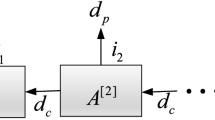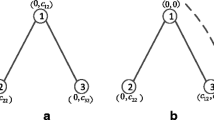Abstract
In this paper, motivated by the usefulness of tensor networks to quantum information theory for the progress in study of entanglement in quantum many-body systems, we apply the hexagon tensor network algorithms in terms of Holland’s theory to study the weight allocation and dynamic problems in weighted quantum secret sharing that are not well solved by existing approaches with near-term devices and avoid the instability in the allocation of participants. To be exact, the variety of matrix product state representation of any quantum many-body state can be used to realize dynamic quantum state secret sharing.









Similar content being viewed by others
Explore related subjects
Discover the latest articles, news and stories from top researchers in related subjects.References
Vidal, G.: Emcient classical simulation of slightly entangled quantum computations. Phys. Rev. Lett. 91(14), 147902 (2003)
Vidal, G.: Efficient simulation of one-dimensional quantum many-body systems. Phys. Rev. Lett. 93(4), 040502 (2004)
Vidal, G.: Classical simulation of infinite-size quantum lattice systems in one spatial dimension. Phys. Rev. Lett. 98(7), 070201 (2007)
Verstraete, F., Porras, D., Cirac, J.I.: Density matrix renormalization group and periodic boundary conditions: a quantum information perspective. Phys. Rev. Lett. 93(22), 227205 (2004)
Schollwöck, U.: The density-matrix renormalization group in the age of matrix product states. Ann. Phys. 326(1), 96–192 (2010)
Navascués, M., Singh, S., Acín, A.: Connector tensor networks: a renormalization-type approach to quantum certification. Phys. Rev. X 10(2), 021064 (2020)
Zhao, H.H., Xie, Z.Y., Chen, Q.N., Wei, Z.C., Cai, J.W., Xiang, T.: Renormalization of tensor-network states. Phys. Rev. B. 81(17), 174411 (2010)
Levin, M., Nave, C.P.: Tensor renormalization group approach to two-dimensional classical Lattice models. Phys. Rev. Lett. 99, 120601 (2007)
Bishop, C.M., et al.: Pattern Recognition and Machine Learning. Springer, Berlin (2006)
Holland, J.L.: Making Vocational Choices: A Theory of Vocational Personalities and Work Environments. Psychological Assessment Resources. Odessa American, Odessa (1997)
Huang, K.Z., Lu, M.W.: Tensor Analysis. Tsinghua University Press, Beijing (2003)
Guo, W., Kotsia, I., Patras, I.: Tensor learning for regression. IEEE Trans. Image Process. 21(2), 816–827 (2012)
Molnar, A., Garre-Rubio, J., Pérez-García, D., Schuch, N., Cirac, J.I.: Normal projected entangled pair states generating the same state. J. Phys. 20(11), 113017 (2018)
Liu, W.Y.: Tensor network states algorithm for two-dimensional quantum many-body systems. dissertation, University of Science and Technology of China
Ekert, A.K.: Quantum cryptography based on Bell’s theorem. Phys. Rev. Lett. 67(6), 661 (1991)
Hwang, W.Y.: Quantum key distribution with high loss: toward global secure communication. Phys. Rev. Lett. 91, 057901 (2003)
Gottesman, D.: Theory of quantum secret sharing. Phys. Rev. A 61(4), 042311 (2000)
Lai, H., Luo, M.X., Xu, Y.J., Pieprzyk, J., Zhang, J., Pan, L., Orgun, M.A.: A quantum secret sharing scheme using orbital angular momentum onto multiple spin states based on Fibonacci compression encoding. Commun. Theor. Phys. 70(4), 384 (2018)
Xiao, L., Long, G.L., Deng, F.G., Pan, J.W.: Efficient multiparty quantum-secret-sharing schemes. Phys. Rev. A 69(5), 052307 (2004)
Hsu, L.Y.: Quantum secret-sharing protocol based on Grover’s algorithm. Phys. Rev. A 68, 022306 (2003)
Ahmadi, M., Wu, Y.D., Sanders, B.C.: Relativistic (2,3)-threshold quantum secret sharing. Phys. Rev. D 96(6), 065018 (2017)
Zhou, Y., Yu, J., Yan, Z., Jia, X., Zhang, J., Xie, C., Peng, K.: Quantum secret sharing among four players using multipartite bound entanglement of an optical field. Phys. Rev. Lett. 121(15), 150502 (2018)
Lu, H., Zhang, Z., Chen, L.K., Li, Z.D., Liu, C., Li, L., Liu, N.L., Ma, X., Chen, Y.A., Pan, J.W.: Secret sharing of a quantum state. Phys. Rev. Lett. 117(3), 030501 (2016)
Acknowledgements
Hong Lai has been supported by the National Natural Science Foundation of China (No. 61702427) and the Fundamental Research Funds for the Central Universities (XDJK2020B027), the Southwest University Research Fund SWU1908043) the Chongqing innovation Project (No. cx2018076). Josef Pieprzyk has been supported by Australian Research Council (ARC) Grant DP180102199 and Polish National Science Center (NCN) Grant 2018/31/B/ST6/03003.
Author information
Authors and Affiliations
Corresponding author
Additional information
Publisher's Note
Springer Nature remains neutral with regard to jurisdictional claims in published maps and institutional affiliations.
Rights and permissions
About this article
Cite this article
Lai, H., Pieprzyk, J. & Pan, L. Analysis of weighted quantum secret sharing based on matrix product states. Quantum Inf Process 19, 418 (2020). https://doi.org/10.1007/s11128-020-02925-w
Received:
Accepted:
Published:
DOI: https://doi.org/10.1007/s11128-020-02925-w




